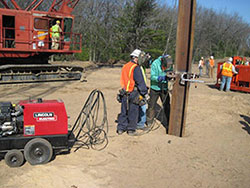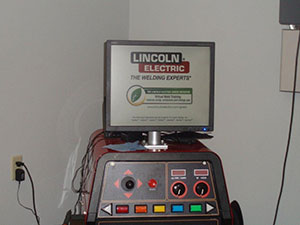Virtual Training: Carpenters Union Incorporates Innovative Education Tool to Prep Students for Crucial Welding Skills and Certification
“We train Millwrights, carpenters, pile drivers and interior systems carpenters. That’s four different types of welding, and the VRTEX® training system covers it all.”

“Because the focus of the carpentry union is to provide the highest trained, most efficient workforce available, each man and woman has to be able to handle the tasks required for each job,” says Joe Weisling, education administrator at the Southeast Wisconsin Carpentry Training Center in Pewaukee, Wisconsin, affiliated with the United Brotherhood of Carpenters (UBC), one of the nation’s largest trade unions.
“Welding is a strong component of that job,” Weisling continues. “We need to have a portable work force. If I’m overseeing a project, and I have a carpenter coming in to build a steel stud wall, why would I wait to call in someone else to do the welding? The UBC strives to provide value to the employer by delivering skilled workers who do what it takes to get the job done and get it done efficiently.”

The UBC takes training seriously and is seeking to deliver a skilled, productive workforce each day to construction sites nationwide. The organization provides training not only at its International Training Center in Las Vegas but also through 140 regional training centers across the country.

“The center provides the necessary proficiency, knowledge and hands-on involvement required to launch a carpentry career,” Weisling notes. “We offer in-depth classroom instruction from skilled professionals using up-to-date training materials, providing a single source to prepare people who form the core of our industry.”
This in-depth training includes welding – a crucial skill that the center brought back into its training program fold about four years ago. The center offers a basic Welding 1 course, a more advanced Welding 2 class and classes for all of the various relevant certifications.
“We realized that by offering the most comprehensive training possible that we could quickly react to developing a workforce that is in tune with ever-changing industry demands,” Weisling says. “At the time when we added welding to our training offerings, there was a big push for power plant work with heavy plate and heavy-gauge steel certifications. Bringing welding training in-house was a natural fit – and it has remained an active part of our program ever since.”
Training in the Virtual Realm
As the educators at the Southeast Wisconsin Carpentry Training Center can attest, most people’s perceptions of their skills are different than what they are in reality.
“That’s why we start our classes with the theory behind what we are teaching,” Weisling says, using welding classes as an example. “Students need to understand the philosophy behind welding and what they are working with before they ever pick up a welding gun. They also need to have an understanding of what it feels like to weld and grasp such concepts as proper technique and muscle memory.”
That’s where virtual reality welding training comes in.
The Southeast Wisconsin Carpentry Training Center is one of the first UBC educational facilities to purchase a VRTEX® 360 Virtual Reality Arc Welding (VRAW™) Training System from Lincoln Electric – a company with which the school has a strong relationship, both in equipment used throughout the facility and also in ongoing educational and technical support. “Our Lincoln Electric representatives are heavily involved in assisting with technical and hands-on training of our students,” states Weisling.

“Before we ever put students in an actual welding booth, we introduce them to the virtual welder,” Weisling says. “Whoever created this system is brilliant because it really facilitates hands-on group learning in the classroom. The instructor, the student doing the welding and the rest of the students in the class can see what is going on. It really brings a sense of teamwork to the learning process.”
The system easily connects with a projector or large LCD display to allow an entire classroom to observe what the welder sees under his or her specially equipped virtual reality welding helmet.
Multiple views show accurate, real-time measurement of such key variables as contact-to-work distance, work angle, travel angle, travel speed and position.
“We can do MIG and stick with different electrodes and wires and so many different positions,” Weisling says. “We train millwrights, carpenters, pile drivers and interior systems carpenters. That’s four different types of welding, and the VRTEX® training system covers it all.”
Students also have access to a virtual on-screen welding terminology and definitions through the system’s “THEORY” button. When the user presses this button on any screen, it immediately pulls up welding terminology and definitions, further tying the virtual experience into the realm of real-world welding and continuing to bolster overall comprehension.
“It’s important to remember that virtual reality welding training isn’t designed to replace hands-on welding,” stresses Deanna Postlethwaite, Business Unit Manager, Virtual Reality Training. “The VRAW system is there to enhance in-booth training. When students use the VRTEX® training system, they learn proper body position and movement and are scored and evaluated through an accurate tracking method that’s built into the system.”
The VRTEX® simulator even replicates proper machine set-up, a necessary component to delivering consistent, quality welds. Before they can “weld” with the machine, students must enter the proper material type, process, gas flow and amperage/voltage/wire-feed speed into the system. They learn how to do this with the help of the VRTEX® Welding Procedure Guide, which features information for all possible welds that can be done on the system.

“We need training that provides all the different aspects of a weld so that our students can pass their certifications,” Weisling says, noting that starting training with the VRTEX® simulations not only helps students become more confident with muscle memory and technique, but it also does it in a manner that is exceptionally time efficient and more cost effective than starting training in a welding booth with an actual coupon and consumables. As Weisling notes, plates needed to create a coupon can cost $12.50 each and electrodes cost upwards of $2 per pound. As such, trial and error in a welding training booth can get costly. Virtual Training: Carpenters Union Incorporates Innovative Education Tool to Prep Students for Crucial Welding Skills and Certif
“Just give an E7018 electrode and 18-gauge steel to someone used to welding on heavy gauge steel,” Weisling says. “It can be hilarious. That’s where the VRTEX® simulator comes in handy – set those parameters, and you’ll quickly learn that you can blow through a stud if you don’t learn the right techniques AND the theory behind it. VRTEX® simulators reinforce both before you put students in the lab. They already will know what to expect – and won’t blow through materials as quickly as a result.”
Because of the fact that the VRTEX® system allows educators to use less raw materials, shielding gas and even energy in a welding booth – reducing carbon foot print and waste – the Southeast Wisconsin Carpentry Training Center has been recognized for creating a “greener training program,” Weisling says. In fact, the center obtained the VRTEX® 360 simulator through a SAGE grant. SAGE is Wisconsin’s Sector Alliance for the Green Economy grant, a $6 million dollar project awarded by the U.S. Department of Labor aimed at helping the state’s workforce employ short- and long-term strategies specific to “green” or clean energy jobs in construction, manufacturing and utility industries.
“The grant has allowed us to be aggressive in instituting this as part of our training program,” Weisling says. “It has been so successful that we’re looking to increase our inventory of VRTEX® training units down the road.”
For the time being, however, Weisling, his staff and the center’s students continue to explore the versatility and functionality that virtual reality welding training and the VRTEX® 360 simulators have to offer.
“We’re still learning all the tools and features that the VRTEX® system provides. Every day, we have a ‘holy cow!’ moment with this machine,” Weisling says. “And every day, we’re finding it to be hugely beneficial in increasingly more ways.”
